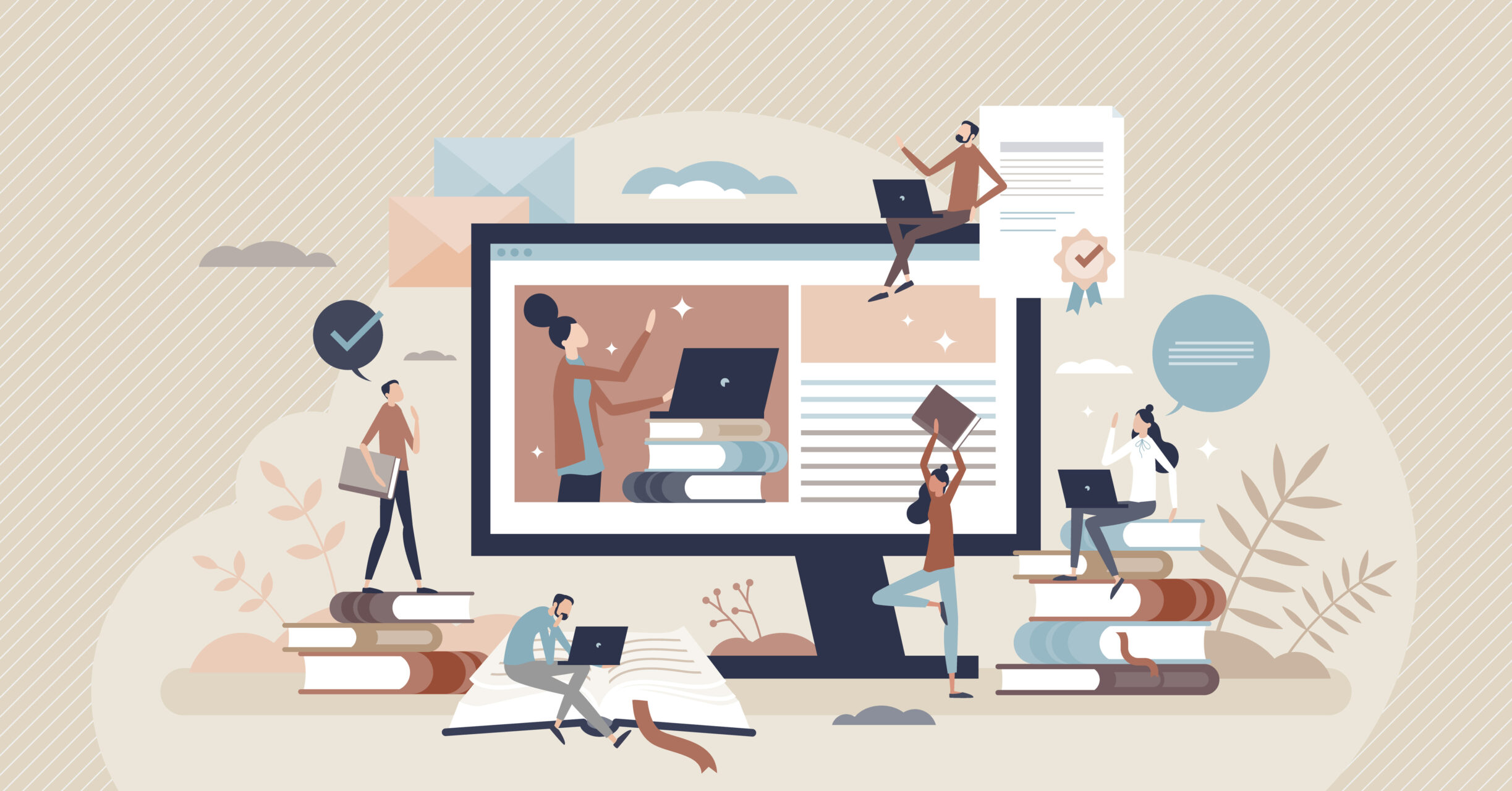The pandemic forced us to adapt to new ways of working and learning nearly overnight. Suddenly, the kitchen doubled as an office, and the classroom became a collection of faces on a screen. As organizations and employees scrambled to adapt, new technologies emerged to support corporate learning and workplace collaboration, forever transforming our brick-and-mortar, pre-pandemic ways of doing business and acquiring knowledge.
As pandemic restrictions eased and workers began to return to the office, it became evident that remote work did not negatively impact productivity or innovation. On the contrary, employees appreciated the flexibility of working from home and learning outside of a traditional classroom setting.
Significant portions of the workforce now expect remote or hybrid options and may even change jobs if they are not available.1 2 Employees expect organizations to help them grow and build capabilities as new technologies emerge at breakneck speeds. The hybrid world of work and learning is now an expectation, not an exception.
Organizations must figure out what a hybrid workplace looks like beyond shared office spaces and state-of-the-art video conferencing tools to meet those expectations and attract and retain top talent. Today, employees seek non-tangible and material benefits. Such abstract perks include flexibility in work arrangements, a sense of belonging and community, personal and professional development opportunities and a sense of purpose in their work.3
The good news is that these trends align with our human biology. Humans are wired to learn, grow and live purposeful lives. Organizations can leverage new developments in the science of learning to craft an employee experience that meets the evolving demands of a hybrid workforce.
Learning in a hybrid environment
Attempts to transcend the boundaries of the traditional classroom environment are not new. While learning patterns (how, when and where) have been changing incrementally over the years, only recently — with the onset of a global pandemic coupled with advances in education technology — could we experience the power of learning anywhere, anytime.
Hybrid learning is an event where some individuals attend virtually online while others are physically present in the same room. Facilitators employ video conferencing tools to deliver instruction live to in-person and online learners simultaneously. The undisputed benefits of hybrid learning include the following:
- Flexibility — you can learn from anywhere, anytime and from any device.
- Affordability — reduction in travel costs such as flights, hotels and rental facilities.
- Safety — if a participant is ill, they can still attend without the risk of infecting others.
However, challenges around learner engagement (boredom, low participation), technical difficulties (unstable or slow internet connection) and miscommunication between instructor and participants (lack of clear body language) continue to frustrate learning designers and participants alike.
How can talent developers overcome challenges with hybrid learning while creating continuity between in-person and remote learners’ experiences? There is a winning approach: Combine education technology with brain-science principles of how we best learn.
New developments in neuroscience help create effective learning solutions
Here are some key findings that can enhance your learning design.
New developments in the neuroscience of learning show that learning continues throughout life, a phenomenon scientists call neuroplasticity (our ability to change or reorganize existing neural pathways) and neurogenesis (the ability to form new neural pathways). It’s never too late for people to learn new skills or change behaviors.
One essential aspect of designing more effective learning is understanding how memory works.
Scientists have discovered nine types of memory: two types of short-term and seven types of long-term memory. Short-term memory includes sensory memory (like noticing the temperature in the room which lasts only seconds) and working memory, which lasts a few minutes, unless something pushes it to long-term memory. As learning designers seek learning transfer and application, moving learned information or behavior from short to long-term memory is the goal.
Long-term memory lasts a lifetime and scientists have discovered both conscious or unconscious types of memory.
Conscious memory includes semantic memory, like learning information or facts. This memory requires effort to be consciously recalled and remembering learned information. Many of us in the learning and development industry work with semantic memory as we train employees on compliance and safety policies, onboard new staff to the organization’s culture and processes or provide knowledge on how to satisfy a customer. If you want learning encoded into long-term semantic memory, information retrieval through quizzes, polls, group discussions and presentations on the topic are effective tools for learning to stick.
The other type of conscious memory is called episodic — the personal memories we each have from lived experiences where we can recall the sights, sounds, smells and sensations. Let’s say you go to Paris on vacation. Your brain takes in all that data through your senses and encodes it as an episodic memory. Later, we can recall that memory by simply seeing a picture of the Eiffel Tower or smelling a croissant, for example. Events activate the memory pathway, bringing it to the surface with vivid clarity.
In his new memoir, “Spare,” Prince Harry shares how he used his mother’s perfume to help unlock memories he had lost of her due to suffering from post-traumatic stress disorder. Smell and music are particularly powerful for eliciting memories. Consider how you might use these in your learning design.
There are five types of unconscious memory including somatic, emotional, non-associative (habituation and sensitization), priming and procedural, which includes learning new skills or habits. We’ll focus more on this last one.
The basal ganglia is the brain structure responsible for helping us learn new skills or develop positive habits.
Suppose you want to train managers on skills like coaching, resolving conflict or creating psychological safety. To ensure the behavior becomes ingrained in memory and can be performed quickly and without conscious effort, learners must practice it repeatedly. The repetition of the behavior is critical to making the learning stick, rather than relying on recall.
Every day, we execute many habits, both professionally and personally. Examples include brushing your teeth, using your smartphone or driving a car. These are tasks we perform on autopilot that do not require conscious effort. The basal ganglia converts frequently performed behaviors into energy-saving neural pathways, allowing us to perform them with minimal effort while preserving brain capacity for other important tasks. These automatic, effortless behaviors are commonly referred to as habits.
As L&D professionals, we must look at forming habits as a framework for thinking about behavior change in the workplace. Here is what we know about habits and how they are formed:
- We need to repeat a behavior at least twenty times to form a new neural pathway.
- On average, it takes 40 to 50 repetitions for the basal ganglia to form a habit where the behavior becomes automatic.
- At 66 repetitions, neurons get thicker, much like muscles that get bigger with use.
Like your muscles, the more you use them, the stronger they get. The implication? To build skills, L&D events should emphasize hands-on practice to help individuals progress as much as possible in forming new habits. Teaching habit design at the start of your learning event is a good strategy too. It helps people understand how we are programmed to continue repeating old behaviors. With this awareness, people can be more participative on their journey to adopting new or better habits.
Understanding habit design and how our brains form and recall memories is essential because they inform which learning methods to use. These brain-based strategies can help overcome challenges in hybrid environments, such as maintaining learner engagement, enhancing retention, preventing feelings of isolation and facilitating the transfer of learning.
Emerging technologies and learning17 18 19 20
Effective learning plays a crucial role in retaining and satisfying employees, making it important for learning designers to approach their work with intention and a focus on evidence-based practices. To achieve this, designers must expand their toolkits and clearly understand when and how to use each tool.
The good news is that the human brain learns through all kinds of activities, ranging from a simple written document to elaborate virtual reality experiences. But you’ll need to pick the tools that are most suited to achieving your goals, supporting your learners and aligning with budgetary and scaling expectations. Many powerful learning methods can be employed with very little technology, such as self-reflection, group discussions, role-plays, quizzes, polls and assessments.
Videos are easy to create and deploy. They activate the mirror neuron system, which helps humans learn through observing others. And, we can also use technology to make these methods faster, better or more affordable.
As the boundaries between the physical and digital worlds become increasingly blurred, L&D professionals must be prepared to integrate cutting-edge, immersive technologies into their training programs as they are revolutionizing the speed at which we learn.
Artificial intelligence and immersive technologies such as augmented, mixed and virtual realities can provide personalized and adaptive learning experiences that create realistic simulations for hands-on learning. Extended reality is already used in the medical field to simulate hands-on training for surgical procedures. It is also used in science classes to demonstrate molecular-level structures that are otherwise invisible to the human eye and in virtual research labs where students gather data in a simulated environment, among others. VR simulations in particular register in the brain as lived experiences, creating long-term memories. Several organizations are leveraging this technology to rapidly scale behavior change while creating safe environments for their learners to practice new skills. It is truly learning by doing and being.
As L&D professionals expand their toolkits and consider incorporating VR and other immersive technologies into their programs, it is a good rule of thumb to use them for experiences that would otherwise be DICE (dangerous, impossible, counterproductive or expensive). Another good rule of thumb is that form follows function. If a PDF solves the problem, you don’t need to build a VR experience. To maintain their competitive edge, learning designers must understand how the brain learns and be skilled at determining the most appropriate technology to incorporate into their instructional events.
Here are five practical tips you can incorporate into your design to make learning stick:
- Start by defining your learning goals, then decide which learning methods will help you achieve them. Ask yourself: What type of memory am I trying to create? Which technology, if any, can help me get there?
- Ensure you factor in several opportunities for participants to practice the behavior you want them to develop. (Remember: Behaviors take 40-50 repetitions to become automatic habits.)
- Break the new behavior into small, easy steps to lessen cognitive overload and ensure learner success.
- Leverage the power of storytelling and visual imagery to create engaging presentations.
- Allocate plenty of individual reflection and time to debrief and learn from large group discussions.
As we continue to work with a hybrid workforce consisting of remote and in-person employees, we must focus on creating a positive employee experience. The key is to design and execute a strategic learning plan that is both effective and impactful. L&D professionals must be prepared to expand their toolkits and consider which tools will have the most significant impact. We must be intentional about when and how we bring people together while attempting to integrate learning seamlessly into their workflows.















